Analyzing the Causes and Effects of the 2020 Recession in Canada
VerifiedAdded on 2022/09/16
|8
|1952
|26
Essay
AI Summary
This essay provides a comprehensive analysis of the causes and effects of the 2020 recession in Canada, primarily attributed to the COVID-19 pandemic. It examines key macroeconomic indicators such as interest rates, GDP, and unemployment rates, highlighting the significant impact on trade, business investment, and consumer spending. The analysis compares the 2020 recession to previous economic downturns, including the 2001 and 2008 recessions, evaluating the potential severity and recovery scenarios. The essay explores the role of monetary and fiscal policies, including interest rate adjustments and government stimulus packages, in mitigating the economic impact. Furthermore, it discusses the effects on international trade, balance of payments, and the concept of comparative advantage, concluding with an assessment of the recession's broad implications for the Canadian economy and potential recovery paths. The author also mentions the impact on the exchange rate of Canada due to the economic performance, interest rate, political uncertainty, inflation and along with uncertainty related to global pandemic.
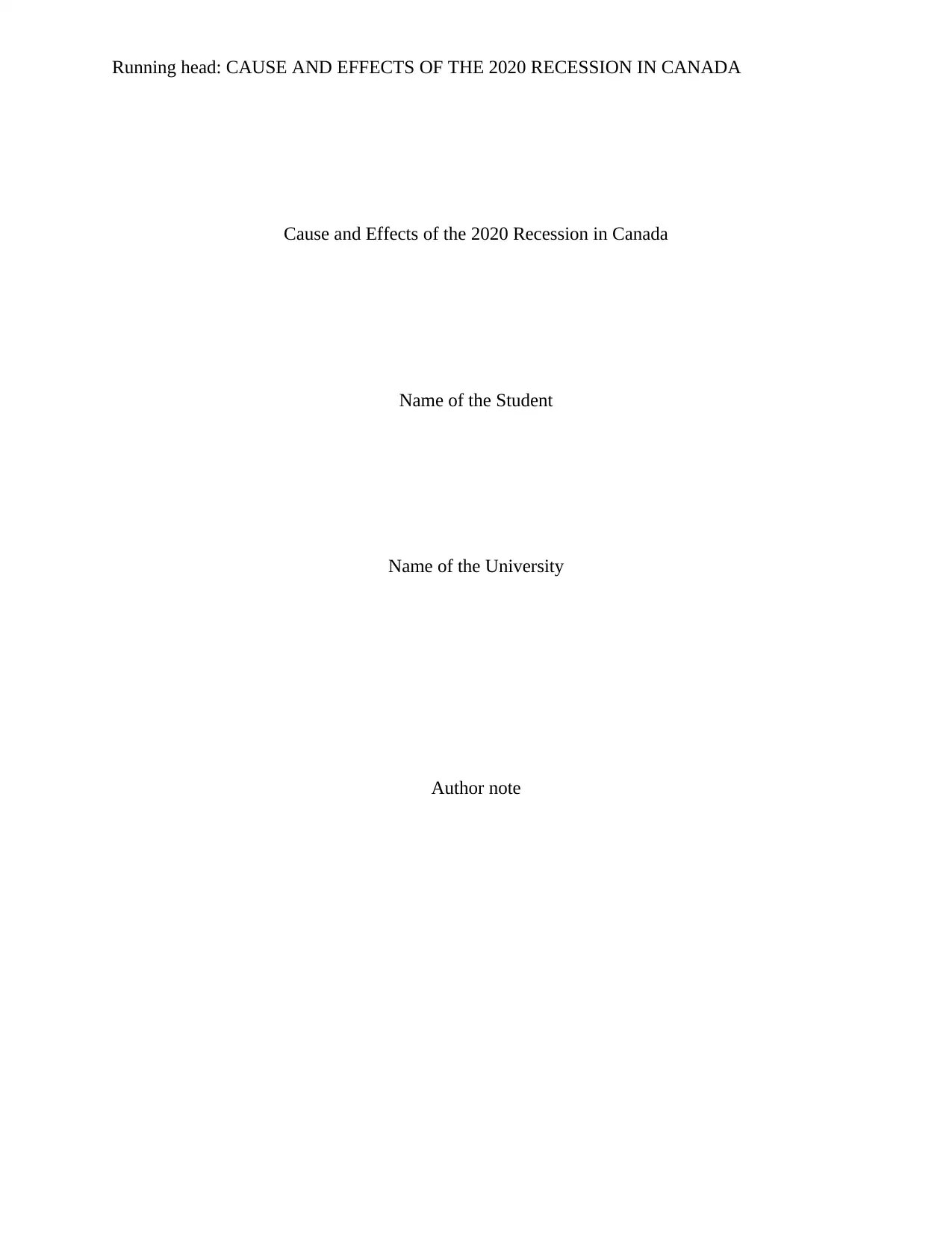
Running head: CAUSE AND EFFECTS OF THE 2020 RECESSION IN CANADA
Cause and Effects of the 2020 Recession in Canada
Name of the Student
Name of the University
Author note
Cause and Effects of the 2020 Recession in Canada
Name of the Student
Name of the University
Author note
Paraphrase This Document
Need a fresh take? Get an instant paraphrase of this document with our AI Paraphraser
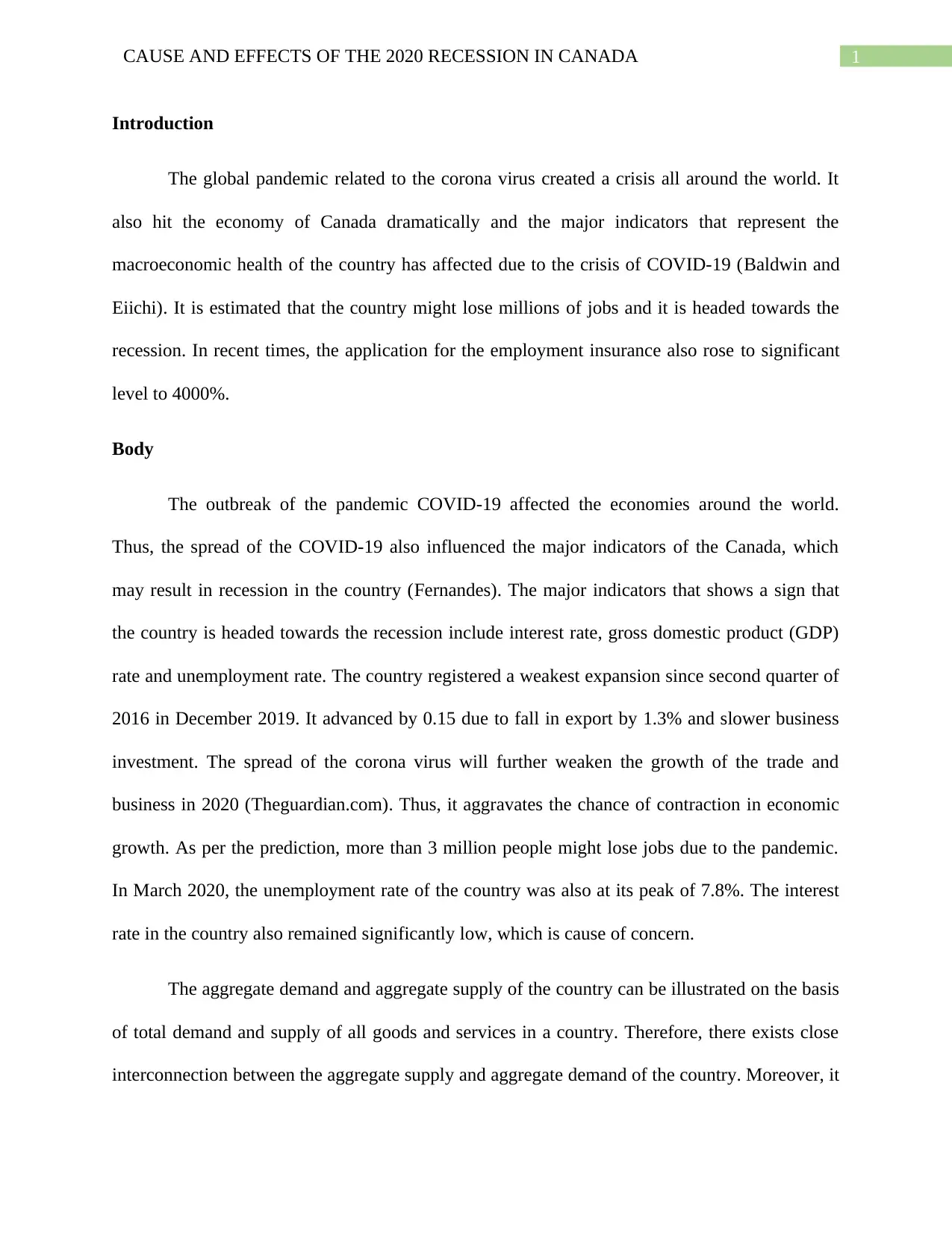
1CAUSE AND EFFECTS OF THE 2020 RECESSION IN CANADA
Introduction
The global pandemic related to the corona virus created a crisis all around the world. It
also hit the economy of Canada dramatically and the major indicators that represent the
macroeconomic health of the country has affected due to the crisis of COVID-19 (Baldwin and
Eiichi). It is estimated that the country might lose millions of jobs and it is headed towards the
recession. In recent times, the application for the employment insurance also rose to significant
level to 4000%.
Body
The outbreak of the pandemic COVID-19 affected the economies around the world.
Thus, the spread of the COVID-19 also influenced the major indicators of the Canada, which
may result in recession in the country (Fernandes). The major indicators that shows a sign that
the country is headed towards the recession include interest rate, gross domestic product (GDP)
rate and unemployment rate. The country registered a weakest expansion since second quarter of
2016 in December 2019. It advanced by 0.15 due to fall in export by 1.3% and slower business
investment. The spread of the corona virus will further weaken the growth of the trade and
business in 2020 (Theguardian.com). Thus, it aggravates the chance of contraction in economic
growth. As per the prediction, more than 3 million people might lose jobs due to the pandemic.
In March 2020, the unemployment rate of the country was also at its peak of 7.8%. The interest
rate in the country also remained significantly low, which is cause of concern.
The aggregate demand and aggregate supply of the country can be illustrated on the basis
of total demand and supply of all goods and services in a country. Therefore, there exists close
interconnection between the aggregate supply and aggregate demand of the country. Moreover, it
Introduction
The global pandemic related to the corona virus created a crisis all around the world. It
also hit the economy of Canada dramatically and the major indicators that represent the
macroeconomic health of the country has affected due to the crisis of COVID-19 (Baldwin and
Eiichi). It is estimated that the country might lose millions of jobs and it is headed towards the
recession. In recent times, the application for the employment insurance also rose to significant
level to 4000%.
Body
The outbreak of the pandemic COVID-19 affected the economies around the world.
Thus, the spread of the COVID-19 also influenced the major indicators of the Canada, which
may result in recession in the country (Fernandes). The major indicators that shows a sign that
the country is headed towards the recession include interest rate, gross domestic product (GDP)
rate and unemployment rate. The country registered a weakest expansion since second quarter of
2016 in December 2019. It advanced by 0.15 due to fall in export by 1.3% and slower business
investment. The spread of the corona virus will further weaken the growth of the trade and
business in 2020 (Theguardian.com). Thus, it aggravates the chance of contraction in economic
growth. As per the prediction, more than 3 million people might lose jobs due to the pandemic.
In March 2020, the unemployment rate of the country was also at its peak of 7.8%. The interest
rate in the country also remained significantly low, which is cause of concern.
The aggregate demand and aggregate supply of the country can be illustrated on the basis
of total demand and supply of all goods and services in a country. Therefore, there exists close
interconnection between the aggregate supply and aggregate demand of the country. Moreover, it
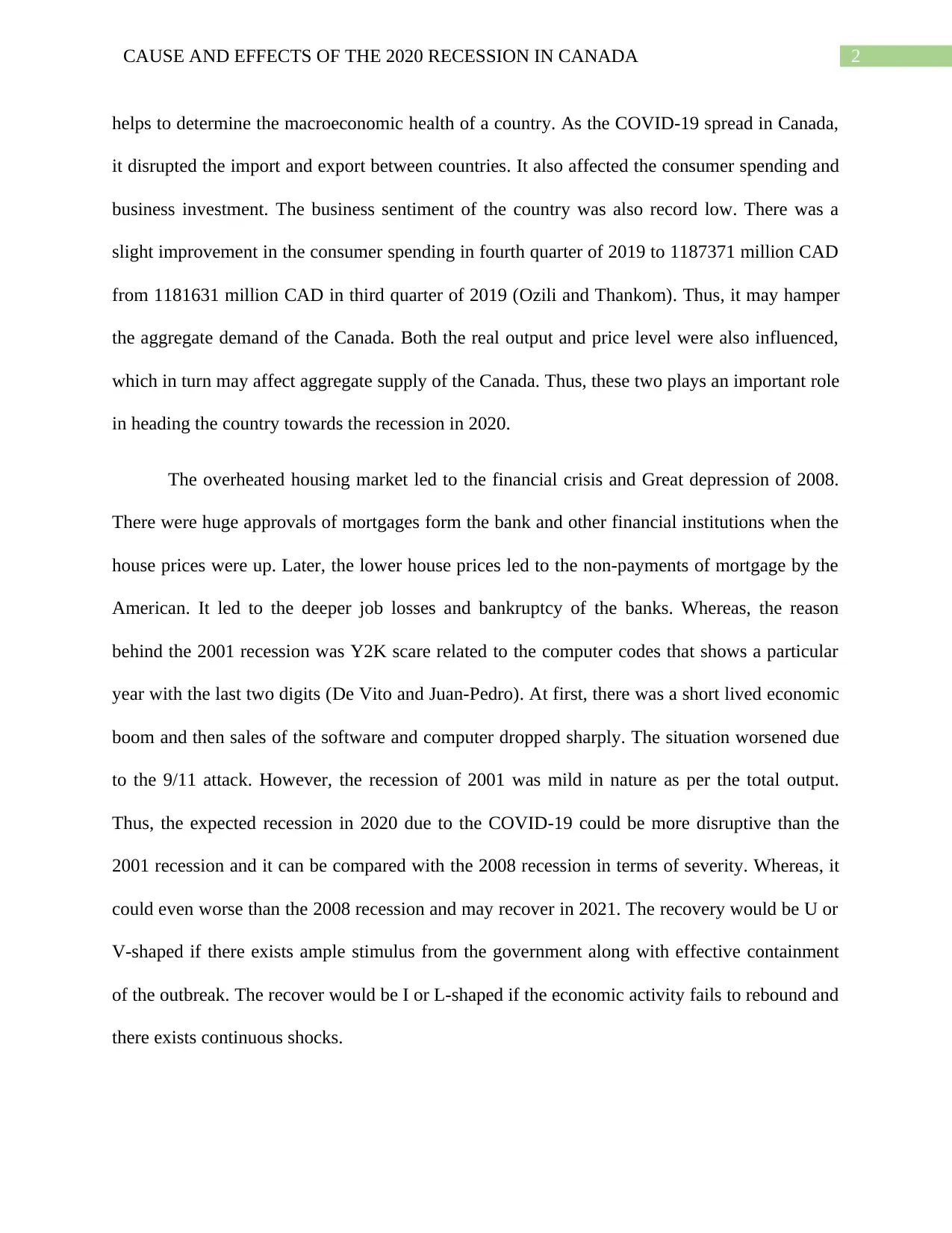
2CAUSE AND EFFECTS OF THE 2020 RECESSION IN CANADA
helps to determine the macroeconomic health of a country. As the COVID-19 spread in Canada,
it disrupted the import and export between countries. It also affected the consumer spending and
business investment. The business sentiment of the country was also record low. There was a
slight improvement in the consumer spending in fourth quarter of 2019 to 1187371 million CAD
from 1181631 million CAD in third quarter of 2019 (Ozili and Thankom). Thus, it may hamper
the aggregate demand of the Canada. Both the real output and price level were also influenced,
which in turn may affect aggregate supply of the Canada. Thus, these two plays an important role
in heading the country towards the recession in 2020.
The overheated housing market led to the financial crisis and Great depression of 2008.
There were huge approvals of mortgages form the bank and other financial institutions when the
house prices were up. Later, the lower house prices led to the non-payments of mortgage by the
American. It led to the deeper job losses and bankruptcy of the banks. Whereas, the reason
behind the 2001 recession was Y2K scare related to the computer codes that shows a particular
year with the last two digits (De Vito and Juan-Pedro). At first, there was a short lived economic
boom and then sales of the software and computer dropped sharply. The situation worsened due
to the 9/11 attack. However, the recession of 2001 was mild in nature as per the total output.
Thus, the expected recession in 2020 due to the COVID-19 could be more disruptive than the
2001 recession and it can be compared with the 2008 recession in terms of severity. Whereas, it
could even worse than the 2008 recession and may recover in 2021. The recovery would be U or
V-shaped if there exists ample stimulus from the government along with effective containment
of the outbreak. The recover would be I or L-shaped if the economic activity fails to rebound and
there exists continuous shocks.
helps to determine the macroeconomic health of a country. As the COVID-19 spread in Canada,
it disrupted the import and export between countries. It also affected the consumer spending and
business investment. The business sentiment of the country was also record low. There was a
slight improvement in the consumer spending in fourth quarter of 2019 to 1187371 million CAD
from 1181631 million CAD in third quarter of 2019 (Ozili and Thankom). Thus, it may hamper
the aggregate demand of the Canada. Both the real output and price level were also influenced,
which in turn may affect aggregate supply of the Canada. Thus, these two plays an important role
in heading the country towards the recession in 2020.
The overheated housing market led to the financial crisis and Great depression of 2008.
There were huge approvals of mortgages form the bank and other financial institutions when the
house prices were up. Later, the lower house prices led to the non-payments of mortgage by the
American. It led to the deeper job losses and bankruptcy of the banks. Whereas, the reason
behind the 2001 recession was Y2K scare related to the computer codes that shows a particular
year with the last two digits (De Vito and Juan-Pedro). At first, there was a short lived economic
boom and then sales of the software and computer dropped sharply. The situation worsened due
to the 9/11 attack. However, the recession of 2001 was mild in nature as per the total output.
Thus, the expected recession in 2020 due to the COVID-19 could be more disruptive than the
2001 recession and it can be compared with the 2008 recession in terms of severity. Whereas, it
could even worse than the 2008 recession and may recover in 2021. The recovery would be U or
V-shaped if there exists ample stimulus from the government along with effective containment
of the outbreak. The recover would be I or L-shaped if the economic activity fails to rebound and
there exists continuous shocks.
⊘ This is a preview!⊘
Do you want full access?
Subscribe today to unlock all pages.

Trusted by 1+ million students worldwide
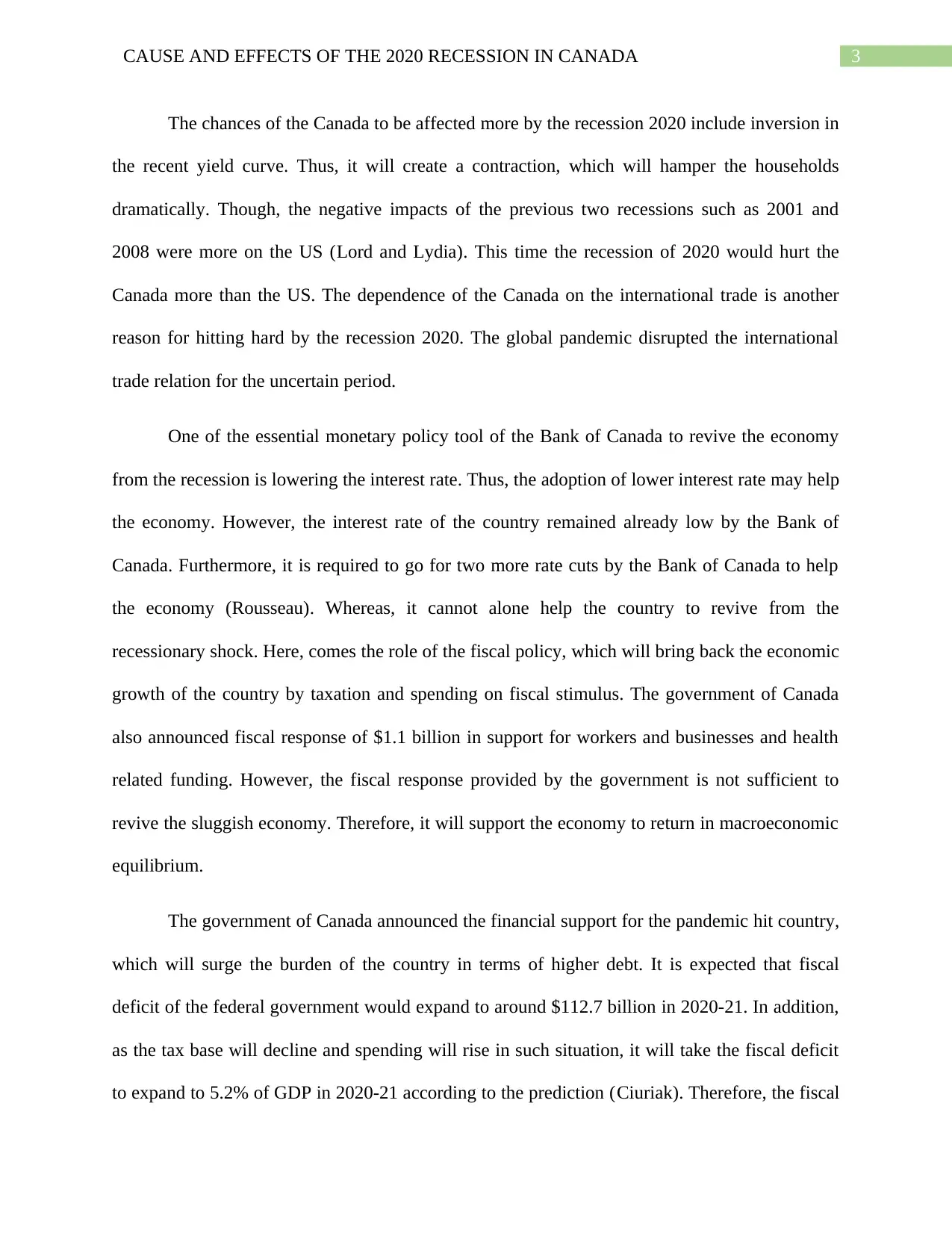
3CAUSE AND EFFECTS OF THE 2020 RECESSION IN CANADA
The chances of the Canada to be affected more by the recession 2020 include inversion in
the recent yield curve. Thus, it will create a contraction, which will hamper the households
dramatically. Though, the negative impacts of the previous two recessions such as 2001 and
2008 were more on the US (Lord and Lydia). This time the recession of 2020 would hurt the
Canada more than the US. The dependence of the Canada on the international trade is another
reason for hitting hard by the recession 2020. The global pandemic disrupted the international
trade relation for the uncertain period.
One of the essential monetary policy tool of the Bank of Canada to revive the economy
from the recession is lowering the interest rate. Thus, the adoption of lower interest rate may help
the economy. However, the interest rate of the country remained already low by the Bank of
Canada. Furthermore, it is required to go for two more rate cuts by the Bank of Canada to help
the economy (Rousseau). Whereas, it cannot alone help the country to revive from the
recessionary shock. Here, comes the role of the fiscal policy, which will bring back the economic
growth of the country by taxation and spending on fiscal stimulus. The government of Canada
also announced fiscal response of $1.1 billion in support for workers and businesses and health
related funding. However, the fiscal response provided by the government is not sufficient to
revive the sluggish economy. Therefore, it will support the economy to return in macroeconomic
equilibrium.
The government of Canada announced the financial support for the pandemic hit country,
which will surge the burden of the country in terms of higher debt. It is expected that fiscal
deficit of the federal government would expand to around $112.7 billion in 2020-21. In addition,
as the tax base will decline and spending will rise in such situation, it will take the fiscal deficit
to expand to 5.2% of GDP in 2020-21 according to the prediction (Ciuriak). Therefore, the fiscal
The chances of the Canada to be affected more by the recession 2020 include inversion in
the recent yield curve. Thus, it will create a contraction, which will hamper the households
dramatically. Though, the negative impacts of the previous two recessions such as 2001 and
2008 were more on the US (Lord and Lydia). This time the recession of 2020 would hurt the
Canada more than the US. The dependence of the Canada on the international trade is another
reason for hitting hard by the recession 2020. The global pandemic disrupted the international
trade relation for the uncertain period.
One of the essential monetary policy tool of the Bank of Canada to revive the economy
from the recession is lowering the interest rate. Thus, the adoption of lower interest rate may help
the economy. However, the interest rate of the country remained already low by the Bank of
Canada. Furthermore, it is required to go for two more rate cuts by the Bank of Canada to help
the economy (Rousseau). Whereas, it cannot alone help the country to revive from the
recessionary shock. Here, comes the role of the fiscal policy, which will bring back the economic
growth of the country by taxation and spending on fiscal stimulus. The government of Canada
also announced fiscal response of $1.1 billion in support for workers and businesses and health
related funding. However, the fiscal response provided by the government is not sufficient to
revive the sluggish economy. Therefore, it will support the economy to return in macroeconomic
equilibrium.
The government of Canada announced the financial support for the pandemic hit country,
which will surge the burden of the country in terms of higher debt. It is expected that fiscal
deficit of the federal government would expand to around $112.7 billion in 2020-21. In addition,
as the tax base will decline and spending will rise in such situation, it will take the fiscal deficit
to expand to 5.2% of GDP in 2020-21 according to the prediction (Ciuriak). Therefore, the fiscal
Paraphrase This Document
Need a fresh take? Get an instant paraphrase of this document with our AI Paraphraser
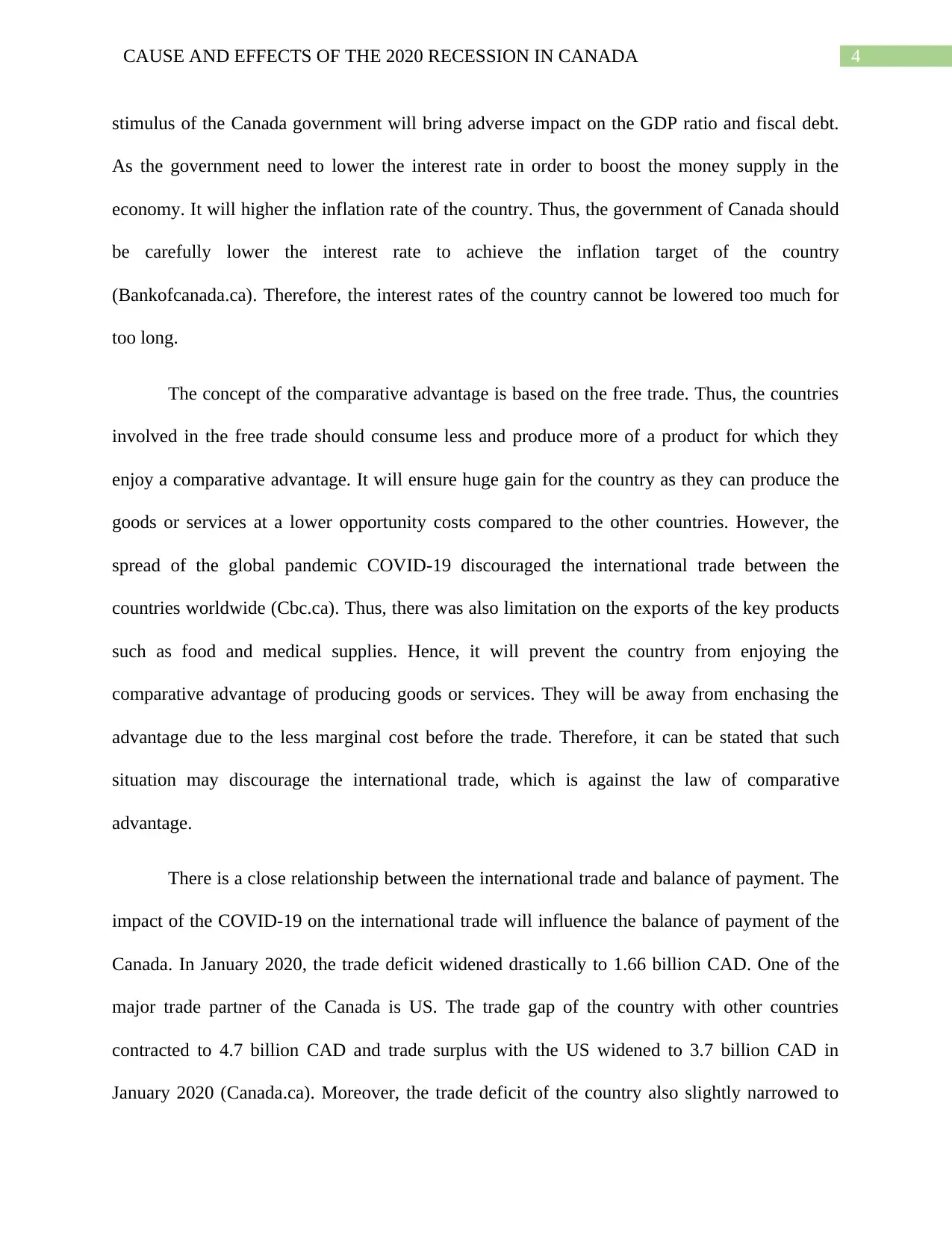
4CAUSE AND EFFECTS OF THE 2020 RECESSION IN CANADA
stimulus of the Canada government will bring adverse impact on the GDP ratio and fiscal debt.
As the government need to lower the interest rate in order to boost the money supply in the
economy. It will higher the inflation rate of the country. Thus, the government of Canada should
be carefully lower the interest rate to achieve the inflation target of the country
(Bankofcanada.ca). Therefore, the interest rates of the country cannot be lowered too much for
too long.
The concept of the comparative advantage is based on the free trade. Thus, the countries
involved in the free trade should consume less and produce more of a product for which they
enjoy a comparative advantage. It will ensure huge gain for the country as they can produce the
goods or services at a lower opportunity costs compared to the other countries. However, the
spread of the global pandemic COVID-19 discouraged the international trade between the
countries worldwide (Cbc.ca). Thus, there was also limitation on the exports of the key products
such as food and medical supplies. Hence, it will prevent the country from enjoying the
comparative advantage of producing goods or services. They will be away from enchasing the
advantage due to the less marginal cost before the trade. Therefore, it can be stated that such
situation may discourage the international trade, which is against the law of comparative
advantage.
There is a close relationship between the international trade and balance of payment. The
impact of the COVID-19 on the international trade will influence the balance of payment of the
Canada. In January 2020, the trade deficit widened drastically to 1.66 billion CAD. One of the
major trade partner of the Canada is US. The trade gap of the country with other countries
contracted to 4.7 billion CAD and trade surplus with the US widened to 3.7 billion CAD in
January 2020 (Canada.ca). Moreover, the trade deficit of the country also slightly narrowed to
stimulus of the Canada government will bring adverse impact on the GDP ratio and fiscal debt.
As the government need to lower the interest rate in order to boost the money supply in the
economy. It will higher the inflation rate of the country. Thus, the government of Canada should
be carefully lower the interest rate to achieve the inflation target of the country
(Bankofcanada.ca). Therefore, the interest rates of the country cannot be lowered too much for
too long.
The concept of the comparative advantage is based on the free trade. Thus, the countries
involved in the free trade should consume less and produce more of a product for which they
enjoy a comparative advantage. It will ensure huge gain for the country as they can produce the
goods or services at a lower opportunity costs compared to the other countries. However, the
spread of the global pandemic COVID-19 discouraged the international trade between the
countries worldwide (Cbc.ca). Thus, there was also limitation on the exports of the key products
such as food and medical supplies. Hence, it will prevent the country from enjoying the
comparative advantage of producing goods or services. They will be away from enchasing the
advantage due to the less marginal cost before the trade. Therefore, it can be stated that such
situation may discourage the international trade, which is against the law of comparative
advantage.
There is a close relationship between the international trade and balance of payment. The
impact of the COVID-19 on the international trade will influence the balance of payment of the
Canada. In January 2020, the trade deficit widened drastically to 1.66 billion CAD. One of the
major trade partner of the Canada is US. The trade gap of the country with other countries
contracted to 4.7 billion CAD and trade surplus with the US widened to 3.7 billion CAD in
January 2020 (Canada.ca). Moreover, the trade deficit of the country also slightly narrowed to
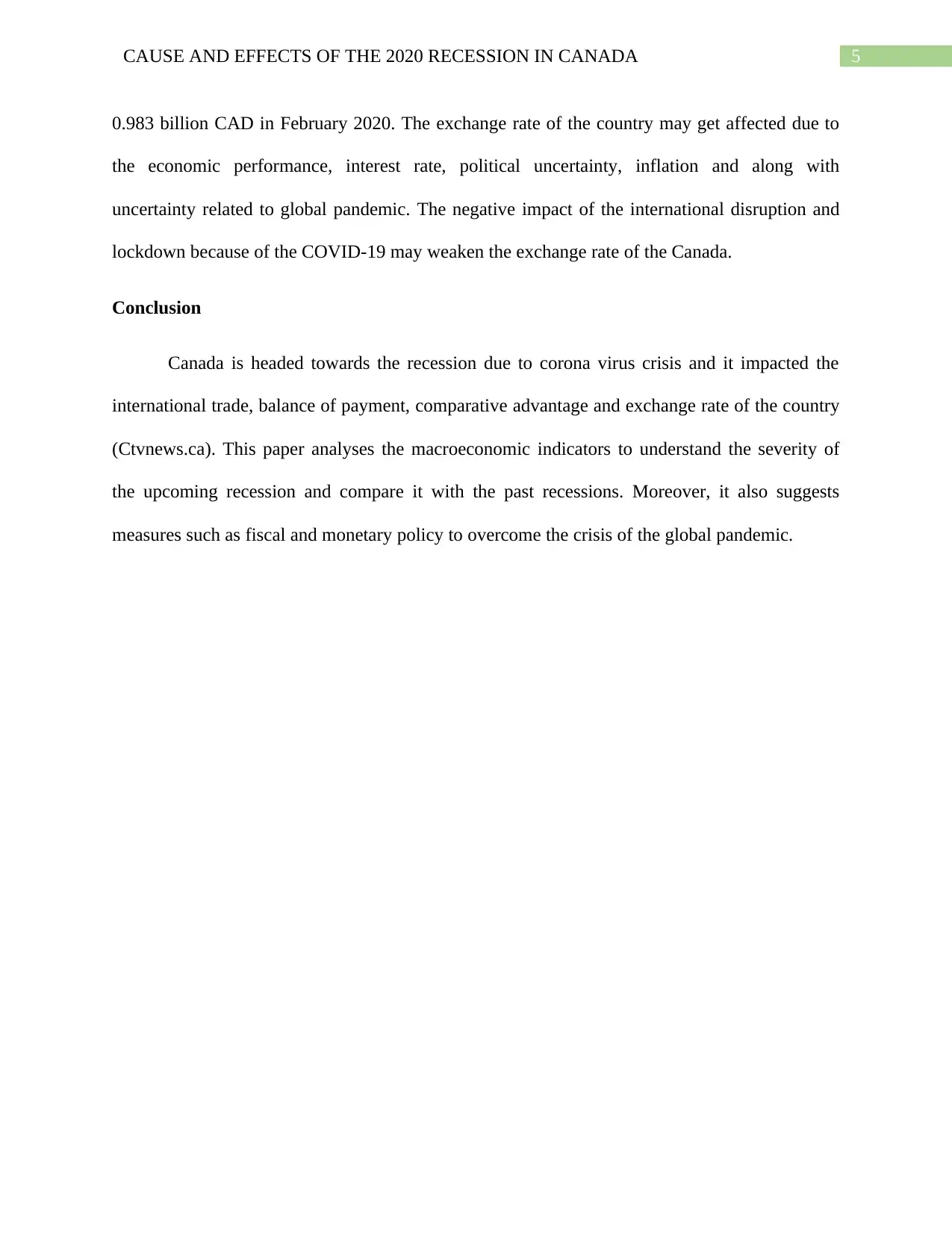
5CAUSE AND EFFECTS OF THE 2020 RECESSION IN CANADA
0.983 billion CAD in February 2020. The exchange rate of the country may get affected due to
the economic performance, interest rate, political uncertainty, inflation and along with
uncertainty related to global pandemic. The negative impact of the international disruption and
lockdown because of the COVID-19 may weaken the exchange rate of the Canada.
Conclusion
Canada is headed towards the recession due to corona virus crisis and it impacted the
international trade, balance of payment, comparative advantage and exchange rate of the country
(Ctvnews.ca). This paper analyses the macroeconomic indicators to understand the severity of
the upcoming recession and compare it with the past recessions. Moreover, it also suggests
measures such as fiscal and monetary policy to overcome the crisis of the global pandemic.
0.983 billion CAD in February 2020. The exchange rate of the country may get affected due to
the economic performance, interest rate, political uncertainty, inflation and along with
uncertainty related to global pandemic. The negative impact of the international disruption and
lockdown because of the COVID-19 may weaken the exchange rate of the Canada.
Conclusion
Canada is headed towards the recession due to corona virus crisis and it impacted the
international trade, balance of payment, comparative advantage and exchange rate of the country
(Ctvnews.ca). This paper analyses the macroeconomic indicators to understand the severity of
the upcoming recession and compare it with the past recessions. Moreover, it also suggests
measures such as fiscal and monetary policy to overcome the crisis of the global pandemic.
⊘ This is a preview!⊘
Do you want full access?
Subscribe today to unlock all pages.

Trusted by 1+ million students worldwide
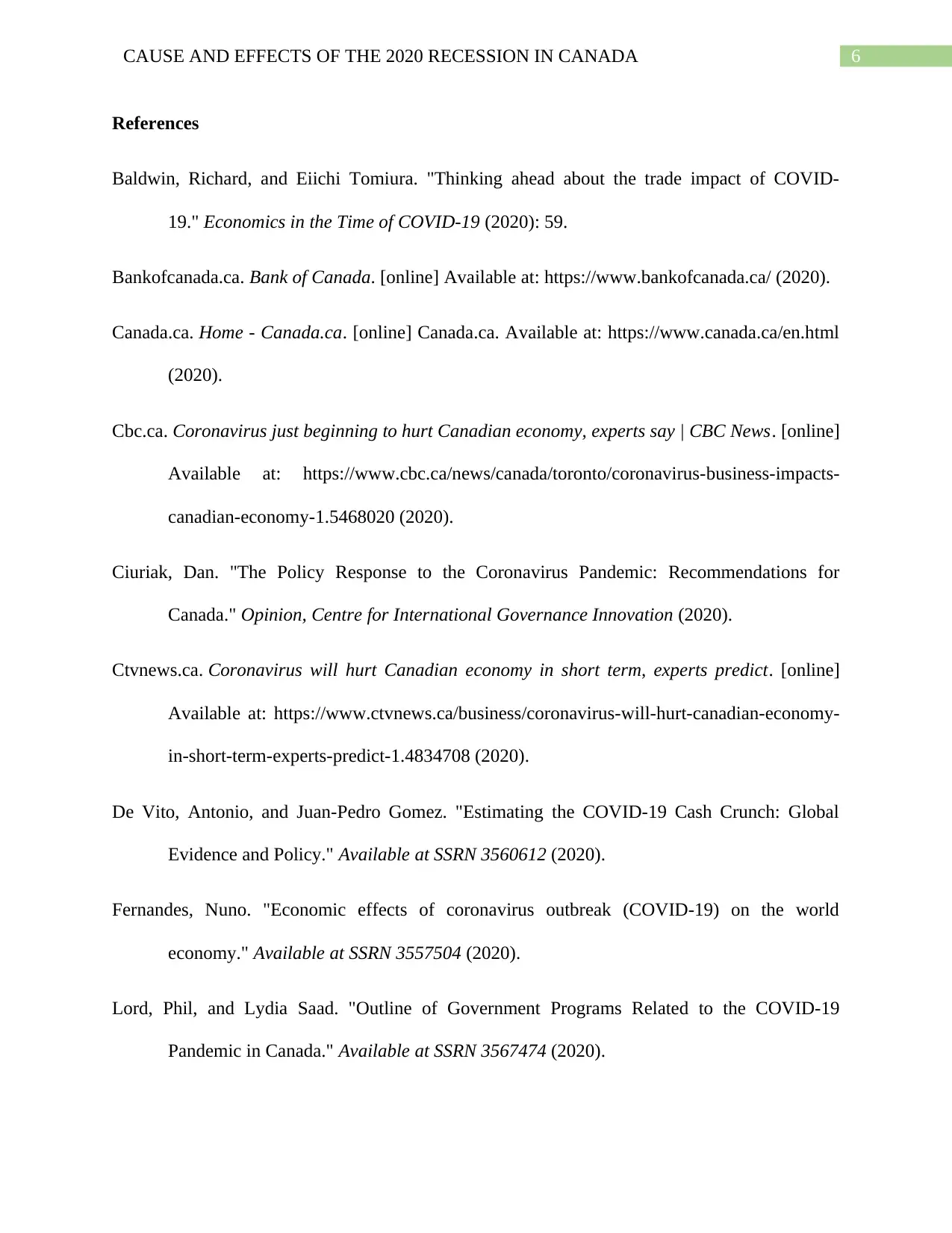
6CAUSE AND EFFECTS OF THE 2020 RECESSION IN CANADA
References
Baldwin, Richard, and Eiichi Tomiura. "Thinking ahead about the trade impact of COVID-
19." Economics in the Time of COVID-19 (2020): 59.
Bankofcanada.ca. Bank of Canada. [online] Available at: https://www.bankofcanada.ca/ (2020).
Canada.ca. Home - Canada.ca. [online] Canada.ca. Available at: https://www.canada.ca/en.html
(2020).
Cbc.ca. Coronavirus just beginning to hurt Canadian economy, experts say | CBC News. [online]
Available at: https://www.cbc.ca/news/canada/toronto/coronavirus-business-impacts-
canadian-economy-1.5468020 (2020).
Ciuriak, Dan. "The Policy Response to the Coronavirus Pandemic: Recommendations for
Canada." Opinion, Centre for International Governance Innovation (2020).
Ctvnews.ca. Coronavirus will hurt Canadian economy in short term, experts predict. [online]
Available at: https://www.ctvnews.ca/business/coronavirus-will-hurt-canadian-economy-
in-short-term-experts-predict-1.4834708 (2020).
De Vito, Antonio, and Juan-Pedro Gomez. "Estimating the COVID-19 Cash Crunch: Global
Evidence and Policy." Available at SSRN 3560612 (2020).
Fernandes, Nuno. "Economic effects of coronavirus outbreak (COVID-19) on the world
economy." Available at SSRN 3557504 (2020).
Lord, Phil, and Lydia Saad. "Outline of Government Programs Related to the COVID-19
Pandemic in Canada." Available at SSRN 3567474 (2020).
References
Baldwin, Richard, and Eiichi Tomiura. "Thinking ahead about the trade impact of COVID-
19." Economics in the Time of COVID-19 (2020): 59.
Bankofcanada.ca. Bank of Canada. [online] Available at: https://www.bankofcanada.ca/ (2020).
Canada.ca. Home - Canada.ca. [online] Canada.ca. Available at: https://www.canada.ca/en.html
(2020).
Cbc.ca. Coronavirus just beginning to hurt Canadian economy, experts say | CBC News. [online]
Available at: https://www.cbc.ca/news/canada/toronto/coronavirus-business-impacts-
canadian-economy-1.5468020 (2020).
Ciuriak, Dan. "The Policy Response to the Coronavirus Pandemic: Recommendations for
Canada." Opinion, Centre for International Governance Innovation (2020).
Ctvnews.ca. Coronavirus will hurt Canadian economy in short term, experts predict. [online]
Available at: https://www.ctvnews.ca/business/coronavirus-will-hurt-canadian-economy-
in-short-term-experts-predict-1.4834708 (2020).
De Vito, Antonio, and Juan-Pedro Gomez. "Estimating the COVID-19 Cash Crunch: Global
Evidence and Policy." Available at SSRN 3560612 (2020).
Fernandes, Nuno. "Economic effects of coronavirus outbreak (COVID-19) on the world
economy." Available at SSRN 3557504 (2020).
Lord, Phil, and Lydia Saad. "Outline of Government Programs Related to the COVID-19
Pandemic in Canada." Available at SSRN 3567474 (2020).
Paraphrase This Document
Need a fresh take? Get an instant paraphrase of this document with our AI Paraphraser
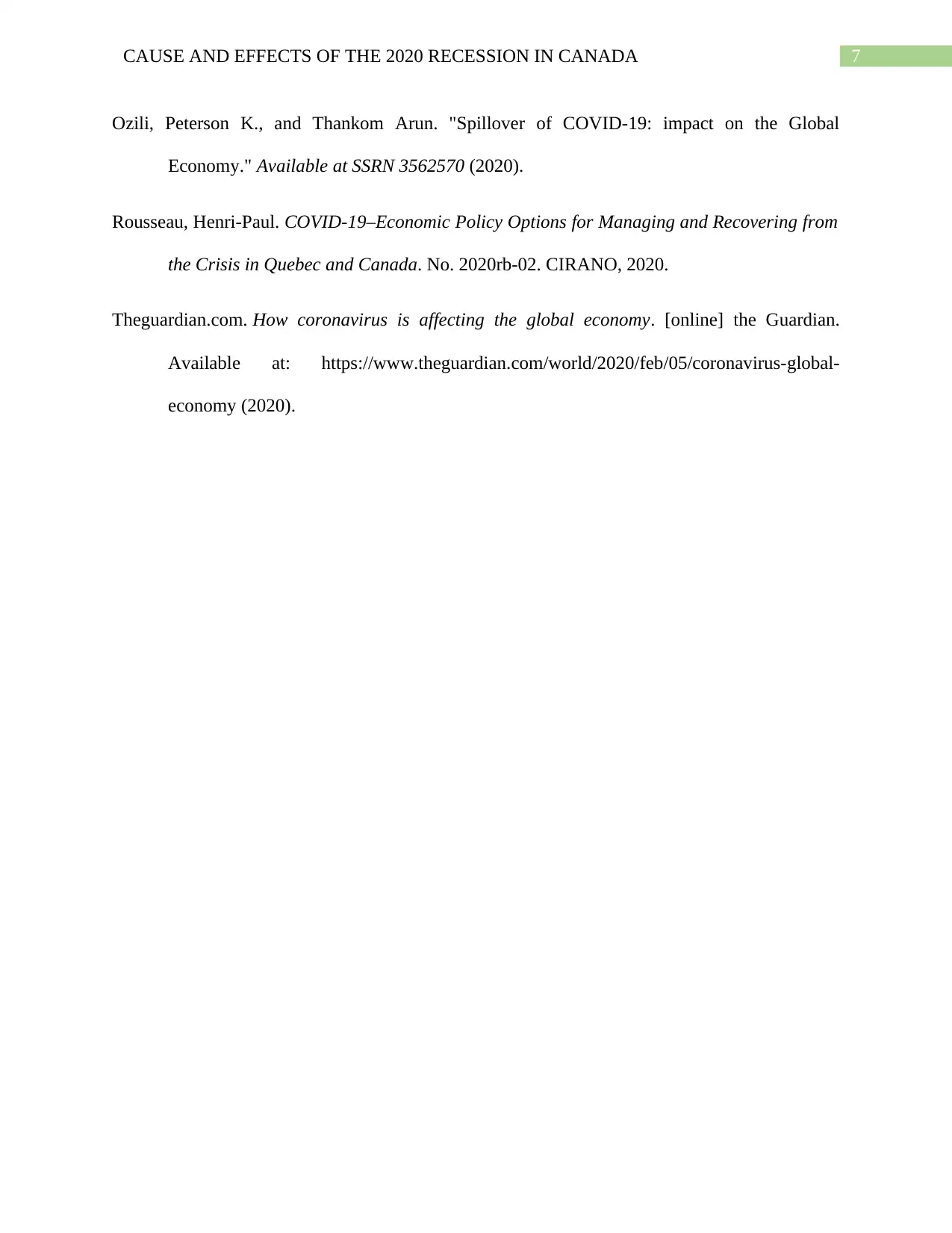
7CAUSE AND EFFECTS OF THE 2020 RECESSION IN CANADA
Ozili, Peterson K., and Thankom Arun. "Spillover of COVID-19: impact on the Global
Economy." Available at SSRN 3562570 (2020).
Rousseau, Henri-Paul. COVID-19–Economic Policy Options for Managing and Recovering from
the Crisis in Quebec and Canada. No. 2020rb-02. CIRANO, 2020.
Theguardian.com. How coronavirus is affecting the global economy. [online] the Guardian.
Available at: https://www.theguardian.com/world/2020/feb/05/coronavirus-global-
economy (2020).
Ozili, Peterson K., and Thankom Arun. "Spillover of COVID-19: impact on the Global
Economy." Available at SSRN 3562570 (2020).
Rousseau, Henri-Paul. COVID-19–Economic Policy Options for Managing and Recovering from
the Crisis in Quebec and Canada. No. 2020rb-02. CIRANO, 2020.
Theguardian.com. How coronavirus is affecting the global economy. [online] the Guardian.
Available at: https://www.theguardian.com/world/2020/feb/05/coronavirus-global-
economy (2020).
1 out of 8
Related Documents
Your All-in-One AI-Powered Toolkit for Academic Success.
+13062052269
info@desklib.com
Available 24*7 on WhatsApp / Email
![[object Object]](/_next/static/media/star-bottom.7253800d.svg)
Unlock your academic potential
Copyright © 2020–2025 A2Z Services. All Rights Reserved. Developed and managed by ZUCOL.



